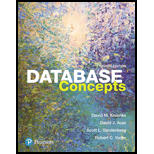
Database Concepts (8th Edition)
8th Edition
ISBN: 9780134601533
Author: David M. Kroenke, David J. Auer, Scott L. Vandenberg, Robert C. Yoder
Publisher: PEARSON
expand_more
expand_more
format_list_bulleted
Concept explainers
Textbook Question
Chapter 1, Problem 1.11RQ
Break the list in Figure 1-34 into two tables, each with data for a single theme. Assume that owners have a unique phone number but that pets have no unique column. Create an ID column for pets like the one created for customers and courses for the Art Course
Expert Solution & Answer
Want to see the full answer?
Check out a sample textbook solution
Students have asked these similar questions
Dijkstra's Algorithm (part 1). Consider the network shown below, and Dijkstra’s link-state algorithm. Here, we are interested in computing the least cost path from node E (note: the start node here is E) to all other nodes using Dijkstra's algorithm. Using the algorithm statement used in the textbook and its visual representation, complete the "Step 0" row in the table below showing the link state algorithm’s execution by matching the table entries (i), (ii), (iii), and (iv) with their values. Write down your final [correct] answer, as you‘ll need it for the next question.
4. |z + 5 - 5i| = 7
14.
dz,
C: |z❘
C: |z❘ = 0.6
ze² - 2iz
H
Chapter 1 Solutions
Database Concepts (8th Edition)
Ch. 1 - Prob. 1.1RQCh. 1 - Prob. 1.2RQCh. 1 - Prob. 1.3RQCh. 1 - Why is the study of database technology important?Ch. 1 - Prob. 1.5RQCh. 1 - Describe the purpose of a database.Ch. 1 - Prob. 1.7RQCh. 1 - Prob. 1.8RQCh. 1 - Prob. 1.9RQCh. 1 - Prob. 1.10RQ
Ch. 1 - Break the list in Figure 1-34 into two tables,...Ch. 1 - Show how the tables you created for question 1.11...Ch. 1 - Prob. 1.13RQCh. 1 - Prob. 1.14RQCh. 1 - Break the list in Figure 1-35 into tables, each...Ch. 1 - Describe in your own words and illustrate with...Ch. 1 - Prob. 1.18RQCh. 1 - Define the term database.Ch. 1 - Prob. 1.20RQCh. 1 - List the components of a database.Ch. 1 - Prob. 1.22RQCh. 1 - Prob. 1.23RQCh. 1 - Prob. 1.24RQCh. 1 - What is the purpose of a DBMS?Ch. 1 - List the specific functions of a DBMS.Ch. 1 - Define the term referential integrity constraint....Ch. 1 - Prob. 1.28RQCh. 1 - List the functions of a database application.Ch. 1 - Prob. 1.30RQCh. 1 - Prob. 1.31RQCh. 1 - Prob. 1.32RQCh. 1 - Prob. 1.33RQCh. 1 - Prob. 1.34RQCh. 1 - Prob. 1.35RQCh. 1 - Prob. 1.36RQCh. 1 - Prob. 1.37ECh. 1 - Prob. 1.38ECh. 1 - Prob. 1.39E
Additional Engineering Textbook Solutions
Find more solutions based on key concepts
Which of the following are illegal variable names in Python, and why? x 99bottles july2009 theSalesFigureForFis...
Starting Out with Python (4th Edition)
This optional Google account security feature sends you a message with a code that you must enter, in addition ...
SURVEY OF OPERATING SYSTEMS
What is an uninitialized variable?
Starting Out with Programming Logic and Design (5th Edition) (What's New in Computer Science)
How does a computers main memory differ from its auxiliary memory?
Java: An Introduction to Problem Solving and Programming (8th Edition)
How are relationships between tables expressed in a relational database?
Modern Database Management
Comprehension Check 7-14
The power absorbed by a resistor can be given by P = I2R, where P is power in units of...
Thinking Like an Engineer: An Active Learning Approach (4th Edition)
Knowledge Booster
Learn more about
Need a deep-dive on the concept behind this application? Look no further. Learn more about this topic, computer-science and related others by exploring similar questions and additional content below.Similar questions
arrow_back_ios
SEE MORE QUESTIONS
arrow_forward_ios
Recommended textbooks for you
- Np Ms Office 365/Excel 2016 I NtermedComputer ScienceISBN:9781337508841Author:CareyPublisher:Cengage
 A Guide to SQLComputer ScienceISBN:9781111527273Author:Philip J. PrattPublisher:Course Technology Ptr
A Guide to SQLComputer ScienceISBN:9781111527273Author:Philip J. PrattPublisher:Course Technology Ptr
 Database Systems: Design, Implementation, & Manag...Computer ScienceISBN:9781305627482Author:Carlos Coronel, Steven MorrisPublisher:Cengage Learning
Database Systems: Design, Implementation, & Manag...Computer ScienceISBN:9781305627482Author:Carlos Coronel, Steven MorrisPublisher:Cengage Learning Database Systems: Design, Implementation, & Manag...Computer ScienceISBN:9781285196145Author:Steven, Steven Morris, Carlos Coronel, Carlos, Coronel, Carlos; Morris, Carlos Coronel and Steven Morris, Carlos Coronel; Steven Morris, Steven Morris; Carlos CoronelPublisher:Cengage Learning
Database Systems: Design, Implementation, & Manag...Computer ScienceISBN:9781285196145Author:Steven, Steven Morris, Carlos Coronel, Carlos, Coronel, Carlos; Morris, Carlos Coronel and Steven Morris, Carlos Coronel; Steven Morris, Steven Morris; Carlos CoronelPublisher:Cengage Learning

Np Ms Office 365/Excel 2016 I Ntermed
Computer Science
ISBN:9781337508841
Author:Carey
Publisher:Cengage

A Guide to SQL
Computer Science
ISBN:9781111527273
Author:Philip J. Pratt
Publisher:Course Technology Ptr


Database Systems: Design, Implementation, & Manag...
Computer Science
ISBN:9781305627482
Author:Carlos Coronel, Steven Morris
Publisher:Cengage Learning

Database Systems: Design, Implementation, & Manag...
Computer Science
ISBN:9781285196145
Author:Steven, Steven Morris, Carlos Coronel, Carlos, Coronel, Carlos; Morris, Carlos Coronel and Steven Morris, Carlos Coronel; Steven Morris, Steven Morris; Carlos Coronel
Publisher:Cengage Learning

SQL Basics for Beginners | Learn SQL | SQL Tutorial for Beginners | Edureka; Author: edureka;https://www.youtube.com/watch?v=zbMHLJ0dY4w;License: Standard YouTube License, CC-BY